HSC Visual Art Resources
A resource site for visual art teachers and secondary students completing their HSC in the Visual Arts
MARIAN DREW
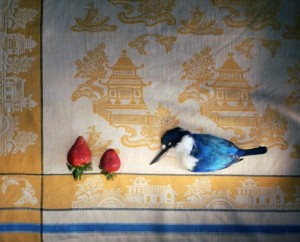
Marian Drew
Australiana/Still life series – Kingfisher with fancy work 2009
giclee print on archival paper
75 x 90cm
image credits: http://www.michaelreid.com.au
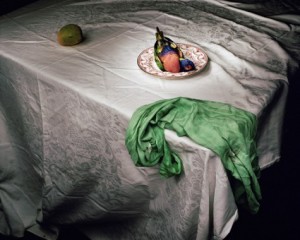
Marian Drew
Australiana/ still Life series – Lorikeet with Green Cloth 2006
archival pigments on hahnemule cotton paper
75 x 90cm
image credits: http://www.michaelreid.com.au
Marian Drew born 1960, Bundaberg Australia, lives and works in Australia.
Marian Drew, a photographic artist, creates still life memento mori’s influenced by both Vanitas and 18th century European still life painting. Each still life depicts an Australian native animal placed on a table with linen and other domestic objects such as fine china, candles, fruit and vegetables. Each image has been beautifully lit, depicting the various settings through light and shadow, carefully composing each of the objects and native animals to create an uneasy stillness.
Drew photographs her still life images in a dark studio using long exposure and a torch light to paint the areas of light into the image. The photographs are exposed onto medium format film, requiring experiementation and bracketin,g as Marian Drew does not see the final effect of this ‘painting with light’ until after the film has been developed.
Its whilst viewing this domestic setting that an audience becomes aware of the limp stillness of each animal, the slightly unnatural composition of their limbs and bodily gestures. For each native creature is merely the remnants of an animal that has been killed through the evolution and expansion of European settlement in Australia. These creatures have been destroyed (either as road kill, by introduced predators, land clearing or urban development) and then collected by Drew to become part of her still life imagery.
Such is the contrast between the embroidered fabrics, delicate china patterns, carefully considered colours and textures that are used alongside the carcasses from the deceased native animals in Drew’s Australiana/Still Life series that reference Vanitas painting and remind us of the fragility of our environment and its inhabitants as well as our own mortality.
In the spring of 2003 I flew back to Brisbane after studying in Germany. The number of dead animals on the road in Australia was such a shock to me after being in Europe. In all the historic still-life painting that I saw in Germany I found what I thought would be the perfect visual response to the road kill. My photographs are as much a response to my own environment as they are to my experiences of a different culture.
– Marian Drew
In the course of daily life these native animals are killed by cars, domestic pets or power lines and are easily found scattered beside the roads through our urban environments.
– Marian Drew
By imitating the historic painted forms of the ‘Still Life’, but replacing paint with photographic verisimilitude, and familiar European animals with Australian native species, a discord is exposed.This work aims to overlay the historical and the present, the European with the antipodean and photography with painting, while exploring contemporary notions of death and a changing relationship to animals
– Marian Drew
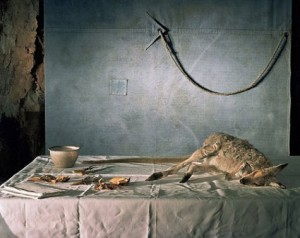
Marian Drew
Wallaby with Tarpaulin 2008
Archival pigments on hahnemule cotton paper
75 x 90cm
image credits: http://www.michaelreid.com.au
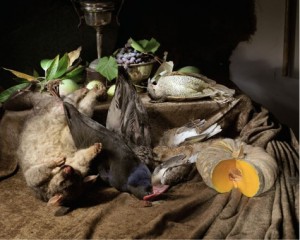
Marian Drew
Australiana/Still Life series – Possum and five birds 2003
Archival pigments on hahnemule cotton paper
75 x 90cm
image credits: http://www.michaelreid.com.au
THE CONCEPTUAL FRAMEWORK:
ARTIST
- Marian Drew photographic artist
- studied 18th century still life painting in Germany
ARTWORK
- large photographic prints
- still life with native animals
- references both still life and vanitas painting
- strong use of lighting, objects and textures
AUDIENCE
- exhibited extensively around Australia
- animals recognisible to the audience as Australian natives
- audience may react in different ways after realising that the creatures are deceased
- audience may or may not recognise the references to vanitas and 18th century still life painting techniques
WORLD
- depicts Australian native animals
- references European painting techniques from the 18th century
- aspects of environmental awareness
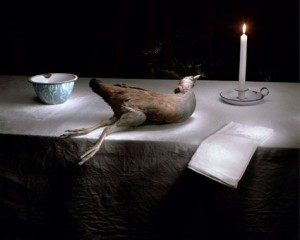
Marian Drew
Australiana/ Still Life series – Swamp hen with candle 2005
Archival pigments on hahnemule cotton paper
75 x 90cm
image credits: http://www.michaelreid.com.au
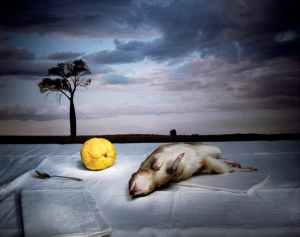
Marian Drew
bandicoot with quince 2005-08
ultrachrome inks on hanemuhle paper
70 x 90cm
image credits: http://www.turnergalleries.com.au
THE FRAMES:
SUBJECTIVE
- uneasiness and mood created through use of strong use of lighting, tone, highlights and low lights
- shock and recoil from realising that the animals in the photograph as deceased and unnaturally represented
- sense of beauty through the use of colours, textures and tones
STRUCTURAL
- strong lighting techniques that mimic 18th century still life painting
- photographic images printed on large sheets of paper
- native Australian animals arranged on table tops with different linens and embroidery as well as various domestic household objects associated with the kitchen.
CULTURAL
- Australian native animals
- presented as still life
- references 18th century still life painting techniques
POSTMODERN
- reinterprets 18th century still life painting techniques in photography as a non traditional form
- appropriates still life compositions
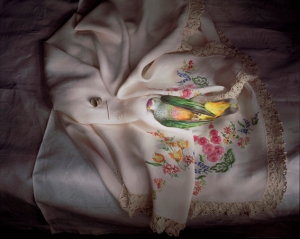
Marian Drew
rose crowned fruit dove 2008-09
ultrachrome inks on hanemuhle paper
70 x 90cm
image credits: http://www.turnergalleries.com.au
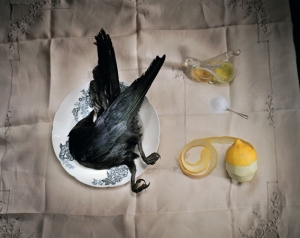
Marian Drew
crow with salt 2003-08
ultrachrome inks on hanemuhle paper
70 x 90cm
image credits: http://www.turnergalleries.com.au
PRACTICE:
- photographic skill and understanding
- lighting techniques to create tone
- collecting deceased native animals that have died through European settlement
- researching still life painting in Germany
- interest in environmental concerns and the effects of urbanisation
- exploring painting techniques through phtoography
- knowledge of vanitas compositions and object symbolism
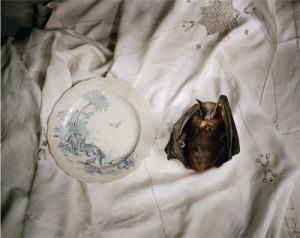
Marian Drew
Fruit Bat and Plate 2003-08
archival pigment on hahnemule cotton paper
70 x 90cm
image credits: http://www.hillsmithgallery.com.au
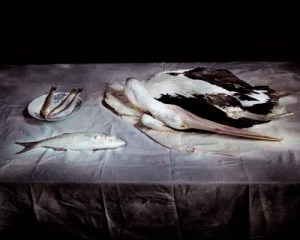
Marian Drew
Pelican on Paper and Linen 2003-08
archival pigment on hahnemule cotton paper
70 x 90 cm
image credits: http://www.hillsmithgallery.com.au
RELEVANT LINKS:
http://www.youtube.com/watch?v=1VKZNJKYEEI
http://www.michaelreid.com.au/artists-view?aid=77
http://www.hillsmithgallery.com.au/stockroom/drew_marian_works.html
http://www.turnergalleries.com.au/exhibitions/09_drew.php
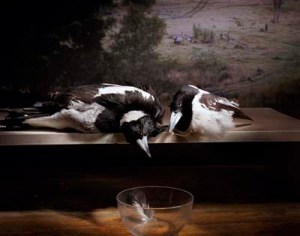
Marian Drew
Magpie and Butcher
archival pigment on hahnemule cotton paper
70 x 90cm
image credits: http://www.hillsmithgallery.com.au

Marian Drew
Butcher with Knife 2003-08
archival pigment on hahnemule cotton paper
70 x 90cm
image credits: http://www.hillsmithgallery.com.au